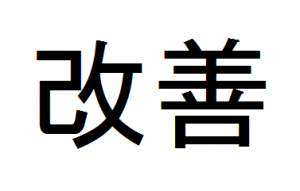How A Small Step Can Change Your Life? – Kaizen Training

Do you want to improve your life but every change is paralyzing you?
Do you lack the time to focus on self-development?
Is there always something keeping you from achieving your goals?
If you answered yes to any of these questions, you might be interested in kaizen training.  Kaizen (from Japanese ‘good change’) is a philosophy, which helps you increase the quality and efficiency of your life.
Kaizen (from Japanese ‘good change’) is a philosophy, which helps you increase the quality and efficiency of your life.
Set an achievable goal and step by step change your life.
The whole idea is based on taking “small steps” to achieve larger goals, effortlessly.
I would like to show you how this philosophy, originally implemented to help restore Japan after the Second World War, can help you right now. I recommend Kaizen techniques to anyone who has completely lost hope in the idea of changing his or her life for the better.
2 MAIN PILLARS OF KAIZEN PHILOSOPHY:
1. Change for the better
2. Continuous improvement process
Kaizen goes beyond just regularity and endurance. It’s a whole strategy developed to confuse your innate resistance to change, and acquire new behaviors without upsetting the natural state of your brain because all improvements should take place gradually.
Change can be scary. The whole point of this approach is to “re-program” your brain to stop being afraid of new patterns and behaviors, because subconsciously we tend to always choose the “familiar, stable now” instead of the “awesome, unknown future”.
Step One: Know What You Want To Get Done
The saying goes that if you don’t know where you’re going, any road will take you there. From a productivity standpoint, this means you better set some goals or you’re going to spend an inordinate amount of time spinning your wheels getting nowhere at all.
What we’re saying, in a nutshell, is that you have to chart out your goals. Here’s how to get it done.
The first step is to brainstorm what your goals are. Start with the long-term, overarching objective. It could be something like “make X amount of dollars in Y amount of time.”
Whatever it is, once you have that long-term goal set, you need to break it down into smaller, short-term goals. These are the stepping stones, the benchmarks you need to hit to get this or that specific task done. Following this process of identifying a big goal then breaking it down into smaller goals helps make the task more manageable, and allows you to set a plan of action for getting it all completed.
Once you’ve got an idea of what you want to accomplish, and you’ve identified your long and short-term goals, WRITE THEM DOWN.
Few things sting as hard as having some killer ideas and then forgetting what they were. Writing your goals down also gives you the chance to order them by priority. If you have a bunch of little goals that play into an overarching win, as in our example, you can chart them out in a way that lets you work steadily towards your big prize.
You might be curious as to how to make sure you’re setting the right goals. Beyond just identifying whether they are short-term or long-term, you can use the “SMART” system to determine whether a goal is worthwhile. The general idea is that each goal you set should be:
- Specific (simple, sensible, significant).
- Measurable (meaningful, motivational).
- Achievable (agreed, attainable).
- Relevant (reasonable, realistic and resourced, results-based).
- Time bound (time-based, time limited, time/cost limited, timely, time-sensitive).
Step Two: Apply Kaizen Training to break your goals
By taking small steps your brain will begin removing obstacles, creating new connections between your neurons, encouraging your brain to get involved in the whole process of change without switching on your preprogramed “fight or flight response”, that you characteristically feel in response to stressful situations.
Many people are afraid of embarrassing themselves in front of others and so they give up, explaining that they didn’t have time, blaming some external circumstances or finding other excuses. The fear of failure overcomes our attempts at self-improvement.
Utilizing the “change in small steps” philosophy of Kaizen we allow our brains to adapt to the behavioral patterns we desire gradually. Later we work more intensively to get even better results. It’s often times so beyond our understanding how the change occurred that we don’t even realize how we actually broke free from the spell of the fear of failure.
Let me give you an example. The classic technique of taking small steps can begin with something as simple as making the following commitment:, “From now on I will workout a minimum of 30 minutes a day, next week a minimum of 45 minutes a day” and so on… However, in the spirit of Kaizen, the above commitment to exercise would be more like: “Ok, I want to be more fit, so I will start today. This week I will exercise 2 minutes a day, next week I will exercise 4 minutes a day etc.” The steps are so incremental, that you won’t even notice the effort put into making them, and you won’t get discouraged so easily. We start automatically doing more, achieving the larger goals we set for ourselves.
As I mentioned before, the fundamentals of Kaizen philosophy were created and implemented by Japanese corporations after WWII, to help restore the economy of the country. And it worked great! Especially for the Toyota Production System, which is known for utilizing Kaizen, and helped to rebuild the whole Japanese industry. Applying some of these rules and methods in our own quest for self-improvement can result in wonderful outcomes.
10 Kaizen Rules:
1. Problems create opportunities.
2. Ask ‘why?’ five times
3. Get ideas from everyone.
4. Think only of applicable solutions.
5. Reject the status quo.
6. Don’t make excuses that something is impossible.
7. Don’t wait for the perfect solution, choose a simple solution.
8. Use your head and not just your money.
9. Regularly correct your mistakes.
10. Self-improvement is a continual process.
How can we simply apply these methods today?
Small steps
First, let’s focus on applying these “small steps”, the spirit of Kaizen philosophy. Remember that small goals lead to more rewards. If your goals are tiny, then everything will be easier. Your brain will think ‘it’s super easy’ I know how to do it, great!
Of course, now it’s time for action, so don’t procrastinate. Choose one small goal each day that will help you improve yourself effortlessly.
If you are somebody who wants to take care of your body, but always finds excuses not to, tell yourself one of these:
– I will do 5 sit-ups in the morning after waking up, or
– I will do 5 crunches in the morning after waking up, or
– I will eat one spoon of rice/noodles/or a bite of pizza less than I used to.
If you want to increase your knowledge and become smarter, tell yourself one of these:
– I’ll read an entry every day from the encyclopedia or
– I’ll read one page of highbrow literature a day.
If you want to learn a new language:
– I’ll learn one new word every day or
– I’ll find and write down one sentence in a language that I want to learn every day
If you want to quit smoking:
– I will throw away one cigarette a day, instead of smoking it
If you feel depressed and lonely:
– Once a day for 2 minutes I will think about some pleasant moment I shared with someone close to me
If you think that sitting all day in front of the computer is damaging your health:
– Once per day I will stand up next to my desk and stretch for a minute, or
– I will get off the bus one stop earlier and walk home.
These goals are so small that they sound ridiculous, but it seriously works wonders after a while. When you get used to them and increase your effort, you won’t even notice that you have.
SMALL QUESTIONS METHOD
Another technique of Kaizen, which we can easily apply to everyday life, is the “small questions” method. Every psychologist agrees that asking yourself questions is more motivating than telling yourself what to do.
For example, if you go shopping for groceries, instead of telling yourself: “now I have to buy something healthy” ask yourself a question: “what healthy food can I purchase here? In this particular case, the point is to program your brain into thinking: ”how can I make myself healthier?” instead of treating it as some kind of obligation. The same could apply to working out. Instead of telling yourself: “I should run more!”, think: “how could I be more fit?” This kind of questioning is much more stimulating than just forcing yourself to do something.
TAKE CARE OF THE SMALL THINGS QUICKLY
Everyone tries to avoid responsibilities from time to time. I already focused on how to stop procrastinating in my previous article but here once again I would like to remind you of the importance of taking care of the small things quickly. Anyone who has many duties knows how important it is to deal with them incrementally.
The small things look so innocent that we tend to ignore them until they pile up and become difficult to deal with quickly. If you have to respond to a message – do it right away. It may take a couple minutes to respond, but try responding to 15 messages that have piled up. It consumes a lot of energy unnecessarily! You should try giving yourself a 2-minute time frame. Make it a rule –if something takes less than 120 seconds, I will do it immediately!
Being able to meet deadlines is important. However, figuring out how to deliver great results every single time you are working on a task is way more significant. And waaaay more difficult…
And what about bigger tasks?
You can also do them little by little, each day or even hour approaching your goal.
Combining Kaizen technique with Pomodoro technique
Breaking down the Pomodoro technique: an effective way to increase your productivity
Pomodoro technique is research-backed time management tool developed by Francesco Cirillo, Basically. The technique requires the use of a timer that is aimed at helping you break down work into intervals. Traditionally, the intervals last for 25 minutes and are followed by short breaks.
In case you have never heard of this technique before, the name itself sounds really interesting. So, the story behind the name is quite simple, actually: each 25-minute interval is known as Pomodoro while the word itself means ‘tomato’ in Italian.
The reason why this tool is so effective is that you get down to break down big tasks into small parts seemingly to Keizen. When you get to deal with 25-minute tasks, it helps you stay refreshed and focused. Therefore, you are able to see noticeable results right away which is the main goal of the technique – to help you increase your productivity and achieve desirable results.
You get to take both short and long breaks which helps you unwind. Yet, those breaks are not long enough to start procrastinating. The official Pomodoro website states that it typically takes people seven to twenty days to master the technique. Not a big price to pay for the ability to deliver excellent results every single time you are dealing with a work problem or a complex task, right? Besides, it works even if you have a large to-do list. The technique helps you break it down into small manageable tasks.
You need to keep in mind that sometimes it is wiser to alter the technique in accordance with your own needs or depending on the task you are currently dealing with. For instance, you can break down the task into 15 or 20-minute-long intervals in case the issue you are dealing with is relatively simple.
Pomodoro technique has helped people increase their productivity and achieve desirable results while taking necessary breaks during the working day. The key aspect is to stay focused on one aspect of the task, do as much as possible during that period of time, as well as take a break for a couple of minutes to refresh and unwind.
Never too late to start new life with Kaizen technique
If you want to change your life you have to start today and stay with it every day. There are no exceptions. Every day you are going to make some small progress, without even noticing it. You will learn that after a week, a month, a year, two years, that there has been a huge change, your progress has been enormous! The steps are so small that you can’t fail.
You can read more about how to apply kaizen principles to your personal development principles in the book written by Anthony Robbins and Robert Maurer ‘One Small Step Can Change Your life: The Kaizen Way.’




Thank you!!
The philosophy of small steps can produce big results. i want to share with you a small animated summary of that book i which you like it: one small step can change your life animated video